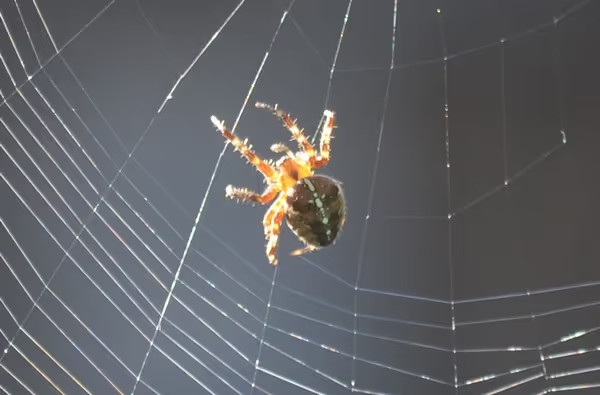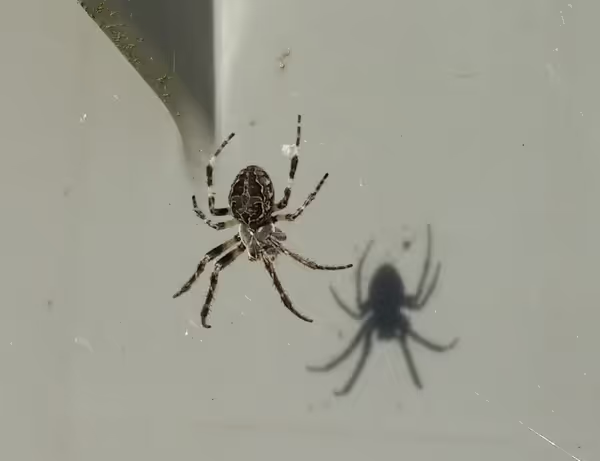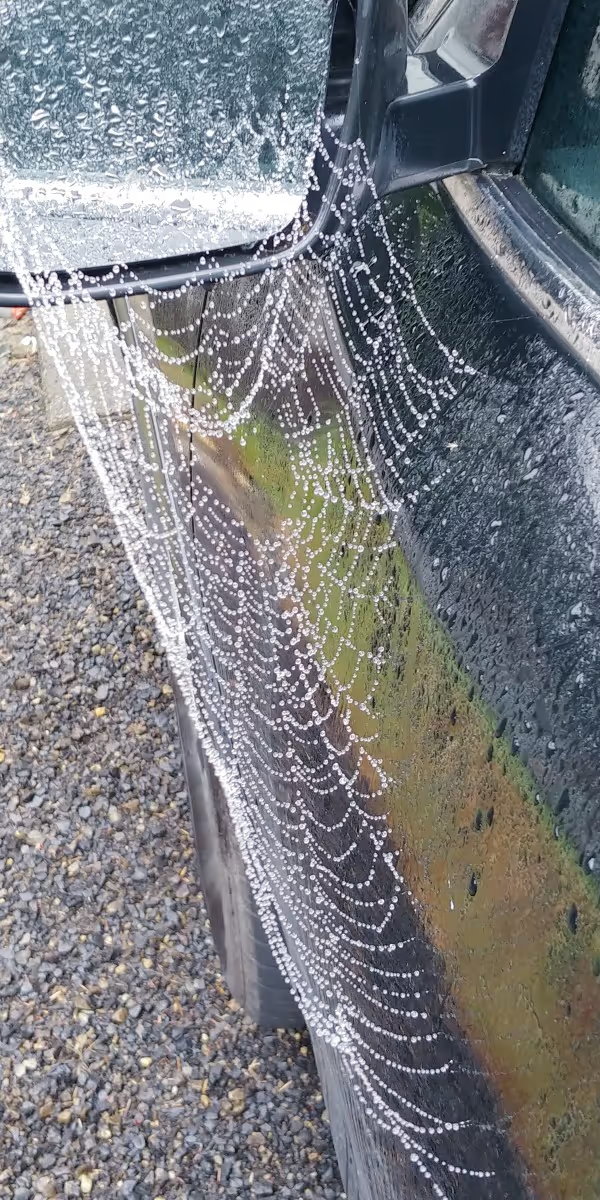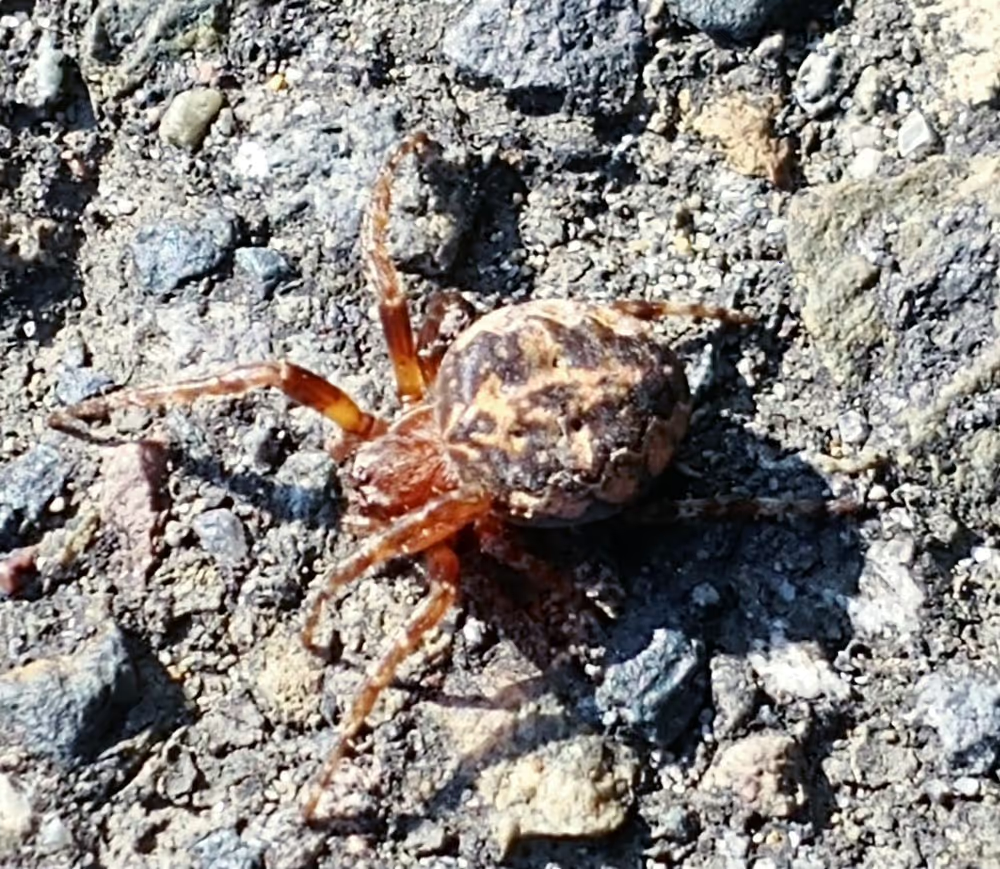Spidery Thoughts


The harbingers of fall are many; colored leaves, harvest of (and frost on) the pumpkin, buck deer stripping the velvet off their antlers, ok, maybe a little chilly rain. None is more fascinating to me than the seemingly sudden appearance of spiders everywhere. In our temperate climate, the spiders mature in late summer and fall, and become actively pursuing mates and prime insect-catching real estate in the form of “web sites.” Oh man, I did NOT intend that pun, but now it is too late.
I went exploring my yard to see if I could put any names to the arachnids I keep bumping into, and take a closer look at their characteristics. With the help of the World Wide Web, I found that by far the most common here is the Cross Orb Weaver Araneus diadematus. I have so many of these around my porch and yard I’ve begun calling the act of venturing outdoors an “immersive experience.” Something will have to be done or my daughter will never come to visit. These are also called European Garden Spiders. The females are much larger than the males, and usually have their mate for dinner after their “date.” These ladies stay in their webs 24/7 unlike other orb weavers who hide during the day. They are beyond efficient at depleting the local mosquito supply. I found varying sizes from 3/8 inch to 1 inch, all with bright diamond-like spots in the shape of a cross on their back. Well, the back of their abdomen.

Later I found a Bridge Orb Weaver Larinioides sericatus (prev. L. sclopetarius). A pretty black-and-white-patterned species, it tends to live on man-made steel objects, seldom on vegetation. This one was on my gray plastic garbage can. These are frequently found close to water, where midges and mayflies are plentiful.

Both these orb weavers were likely introduced to British Columbia from Europe and spread from there. Orb weavers are not dangerously venomous to humans or pets. Charlotte of Charlotte’s Web is an orb weaver, of course. Two Araneus diadematus individuals (named Anita and Arabella) were sent into space in 1973 so scientists could study web spinning in zero gravity, and Cross Spiders were used in experiments in the late ‘40s and early ‘80s on how psychoactive drugs affect a spider’s ability to spin webs.
It is reported that orb weavers spin a new web every day. If that were true, then why don’t we have lots of empty spare webs hanging around? Well, because they eat the old one first! They reuse the foundation lines and replace the radii and spirals, perhaps just half the web or a damaged portion at a time. The instinctual (not learned) art of web construction is to drop a line from a high point to an anchor point, assisted by the wind, climb up and drop another, forming a Y. Then radii are formed like spokes of a wheel. This framework is made of nonsticky silk. When the radii are laid out, either one or two spirals are laid between the spokes using sticky-droplet-covered silk. Among spiders there are seven different types of thread-producing glands, each for a thread of a different purpose. Any individual spider may have several of these glands (but not all seven). Each spider may have one to four pairs of spinners, which are connected to the thread glands by tubes. Each spinner has its own function, one for webs, one for prey wrapping, one for egg sacs, one for quickly dropping away from a predator, and so on.
There is thought that the evolution of three-dimensional webs (cobwebs, sheet webs, funnels) occurred because it is more difficult for predators (such as mud-dauber wasps) to succeed in capturing a spider out of a three-dimensional web than from a two-dimensional circular web. An expert at three-dimensional web building is my friend the tub-visiting Giant House Spider Eratigena atrica. He builds a funnel web. These startling specimens were also introduced to southern British Columbia in the early 20th Century and spread southward to Washington and beyond. The body of the female is larger than the male, but the leg span of a male can be twice as large as the female. The webs are flat and messy with a funnel at one end. The presence of these spiders may be a deterrent to their relative the poisonous Hobo Spider. The one that visited me a few years ago gave his name as Giant House Spider and I am not planning to insult him by saying he was a Common House Spider. The venom these spiders carry is no more harmful to humans than a bee sting.
I was surprised to find this Sac Spider (Cheiracanthium sp.) sitting in an orb-shaped web. Normally this spider doesn’t build a web but constructs a silken tube or sac in a hidden, protected spot, into which they retreat in daytime. They hunt small insect prey by running about waving their long front legs. These spiders do have a cytotoxic bite but it is much less venomous than that of the brown recluse. I guess this individual was opportunistically using an empty orb weaver web, or maybe that orb weaver became prey to the sac spider. Or maybe my identification is wrong, for that matter. This is my first try.

As you may have guessed, I am not among the “It Has Eight Legs, Kill It” faction nor do spiders frighten me. My calm interaction with one on my skirt in 7th grade Social Studies class helped to solidify my “weird nerd” status. This spring of 2020, with its limited driving about, resulted in the discovery that my vehicle has lovely anchoring points for a variety of web designs. I built a relationship with orb-weaver Zelda, who loved my driver’s side mirror. She lived behind the mirror and came out nightly to rebuild her architecture. She caught several hundred white flies one morning. Another morning the monument she built was laden with dew. She traveled to Montana with me in June. On a trip to Hoquiam one day, she came out while we were moving (spiders respond to web vibration which usually indicates prey was caught) and I stopped to take a picture because she had been shy and elusive at other times. When I got out of the car to snap a photo from the other side, she dropped to the ground. The sorrow and panic I felt can only speak to the fact that this isolation business has gone too far!



There are myths and superstitions abounding in every human culture about spiders, and while many people fear them greatly, most of the superstitions indicate spiders bring or foretell good fortune. We know their insect-eating benefits, for sure. I use the cup and card method (or in Giant House Spider cases, wide-mouth Mason jar and cardboard) of removal from my living spaces. An alternative to killing outside is to use a broom to move the webs away from eaves, porches, window and door frames and move them to the trees and other vegetation.
Most of the 4,000 or so species of spiders in the United States are not poisonous to humans beyond causing an itchy bump like many other insect bites. There are just THREE species in Washington whose bite can cause more serious skin lesions or systemic harm if their venom is injected. Those are the Black Widow (Latrodectus sp.), the Hobo Spider (Tegenaria agrestis), and the Yellow Sac Spider (Cheiracanthium sp.) The Washington State Department of Health maintains that Brown Recluse spiders do not yet live in Washington, they seldom stray west of the Rocky Mountains at this time. Hobo spiders are sometimes mistaken for Brown Recluses. Spiders of any kind generally “bite” only if pressed up against a person’s skin, so the best prevention is brushing any spider that lands on you off, and shaking out your clothes and shoes if they are stored where spiders “hang out.”
In conclusion, whether it’s a sparse spider season or a plentiful one, spiders are for the most part beneficial to our environment. Be careful, but also be full of care for these fascinating creatures.
Image Credits: Virginia Molenaar
© Virginia Molenaar, October 2020
Touch whale bones, examine shipwreck artifacts and connect with the coast's living history.

Support our mission, get involved in educational programs, or contribute through donations and volunteering.